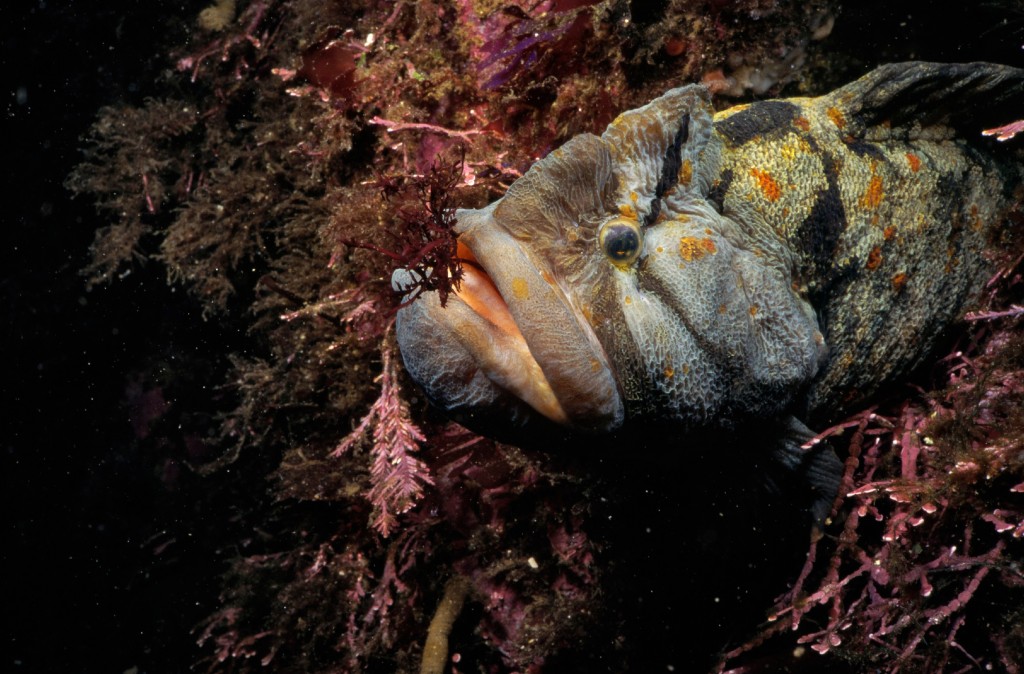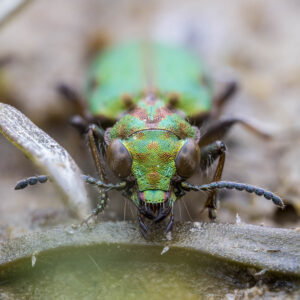n an overcast afternoon in the fall of 1996, while casting his line from “Squack Rock,” a not-so-affectionately named craggy outcrop near Pescadero, Kirk Lombard paused to watch a skinny, middle-aged man in a beat-up wetsuit hop around the rocks with a bamboo stick. The man slid the stick between the cracks of the rocks, somehow hooking half a dozen fish in a matter of minutes. Lombard hadn’t caught a thing all day. Intrigued, he climbed down from Squack Rock to ask the man who he was and what he was up to.
“Call me Cambodian Stan,” said the man. “This” — he gestured at the 4-foot-long bamboo pole and out to the rocks below his feet — “is called poke poling.”
“Poke poling?” Lombard asked.
“Poke poling,” Stan confirmed. He waved dismissively at the ocean. “Don’t cast out there,” he said. “They’re right under your feet!”
Stan showed Lombard the metal hook at the end of the bamboo pole where he had skewered his bait, and plunged it into a water-filled cavity at the base of Squack Rock. Shortly afterward Stan pulled out a cabezon – a large-headed sculpin – and that, Lombard says, is the moment he decided to abandon his rod and reel.
The next day Lombard found a patch of bamboo growing near the San Francisco airport and chopped down a few poles. He never saw his muse again, but over the next 18 years Lombard would achieve semi-fame as the “Sea Forager,” known to restaurants and the press as the poke-poling hunter of the monkeyface eel.
Lombard, a former wildlife inspector for the California Department of Fish and Wildlife who now runs a commercial fishing business and leads undeniably strange coastal walking tours, is by nature a dramatic character. He’s an athletic man, whose signature black-framed glasses have appeared on numerous magazine and newspaper covers. He is distractible, and in his unbridled enthusiasm sometimes interrupts his own outlandish anecdotes. His infrequently used blog, monkeyfacenews.com, is a collection of fishing tidbits, self-promotion, and unusual musings on the state of the world. He has posted a 5-minute musical ode to Cambodian Stan on YouTube.
Lombard acknowledges that the details of his encounter with Cambodian Stan have faded some in the last two decades, which may explain why the tale is slightly different in each media re-telling.
But no matter the details of the encounter, there is always one nugget at the heart of the story: the monkeyface eel.
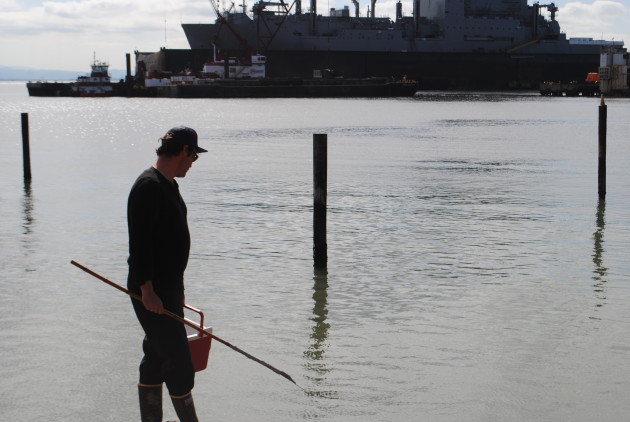
he monkeyface eel lives its life like it’s keeping a secret.
Monkeyface eels (Cebidtichthys violaceus) range from Oregon to Baja California, but an individual monkeyface doesn’t wander farther than 15 feet from its preferred rock crevice in the intertidal zone. In fact, the monkeyface is so disinclined toward movement that it evolved accessory breathing organs that serve as lungs so that it can stay put while the tide has gone out, breathing air for up to 35 hours at a time.
The monkeyface may not change location, but it sure can change its diet: as juveniles, monkeyfaces are crustacean-eating carnivores, but they become herbivores once they reach a few inches in length. In adulthood (they can live up to 18 years) they dine on algae, but occasionally “lower their standards and accept a piece of squid offered to them at the end of a bamboo pole,” Lombard says.
The Gulf of the Farallones Marine Sanctuary Association has a monkeyface on display at its visitor center. They have named it Monty; Sanctuary spokeswoman Mary Jane Schramm says Monty has a “low-key” personality, a “quiet” charisma and a frequent “habit of concealment.”
One thing the monkeyface is concealing is that it isn’t a true eel.
According to Dave Catania, the senior ichthyology collections manager for the California Academy of Sciences, the monkeyface, though long and slender, does not fall into the true eels order, Anguilliformes. This sort of misnomer is pretty common, Catania says. The wolf eel that lives off of California’s shores isn’t an eel either: like the monkeyface, it belongs to Perciformes, the largest order of modern bony fishes.
Besides being a poser, the monkeyface is also widely known for having a face that could incite a thousand ships to retreat to harbor. The Monterey Bay Aquarium’s website describes the monkeyface as having “a bluntly rounded snout, large fleshy lips, and … a lumpy ridge [on its head].” In a 2004 article in the San Francisco Chronicle, food writer Peggy Knickerbocker called them “ugly as sin.”
Lombard says the fish’s face has a “simian quality” to it, due in part to the placement of its eyes, which rather than looking out from the side of its head like a fish’s, stare morosely from the center of its face.
But there is superficial beauty, and there is beauty on the inside. And the monkeyface is beautiful on the inside, or, at least, it is delicious, which to someone like Lombard is sort of the same thing.
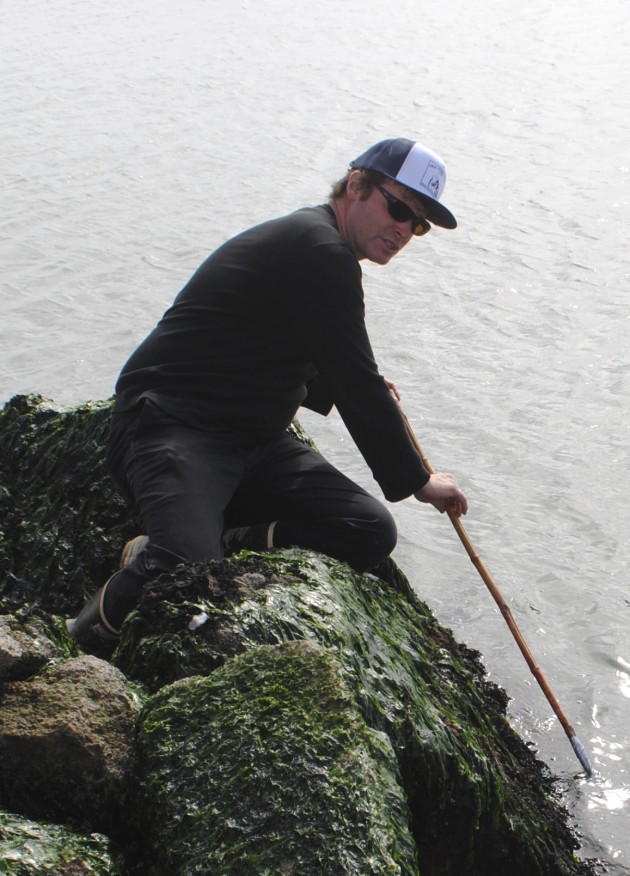
CAN’T KEEP UP WITH THE DEMAND!” Lombard shouts from the water’s edge.
The 50-year old fisherman has perched himself on a pile of boulders at the waterfront along Terry A Francois Blvd in San Francisco, amidst jade-green sea-grass that reminds me of fetuccini. He’s spouting obscure biology and swearing like a sailor, projecting across the water with the amplification he acquired in 15 years as a stage actor in New York. (That was before he moved to California and worked for Fish and Wildlife.) He holds his bamboo pole daintily, like a painter with a paintbrush.
Lombard brought me here to illustrate a point that monkeyface eels are everywhere. He prefers to fish them along the oceanfront, but even in ideal conditions he rarely catches more than 10 a day, which is nothing like what restaurants in the Bay Area demand.
Kenny Belov, the owner of FISH restaurant in Sausalito and the co-owner of a sustainable seafood distribution company called TwoXSea, partnered with Lombard years ago on a sustainable seafood enterprise. They started out in the days when Lombard sold as many monkeyfaces as he could catch; lately, Lombard has diversified his seafood portfolio and his business has grown so rapidly that he simply doesn’t have the time to fill large monkeyface orders.
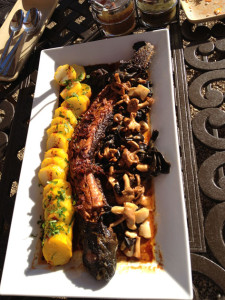
“We’d have a standing order of 40 eels a week,” Belov says, for which he said he’d easily find buyers like Chef Mateo Granados of Healdsburg’s Cocina Latina.
Granados would roast the eels and serve them whole.
“I would buy as many as [Belov] had, and still sell out by the end of the week,” Granados says. “People loved it. They would call me to see if I had the monkeyface. They still do.”
Chez Panisse legend Alice Waters also has served monkeyface eel, and would go poke-poling with Jean-Pierre Moullé when he worked as a chef in her restaurant.
“There’s definitely a demand,” Belov says.
Monkeyface meat is fluffy and white, and holds together well in cioppino and gumbo. Granados describes the texture as a mixture between monkfish and lobster, “delicious,” he says, “in a tomato caper sauce.”
The monkeyface is destined to remain an uncommon dish, however, by virtue of its biology. The species’ habitat still can only be reached by hand (or bamboo pole), so the commercial monkeyface industry will likely remain, as the Monterey Bay Aquarium puts it on its website, “insignificant.”
“No fisherman in his right mind would try to make a living doing this,” Lombard says.
ombard is trying to make a living doing this. He runs what’s called a Community Supported Fishery (CSF) program, “Sea Forager Seafood,” which has 323 subscribers to whom he delivers a box of fresh seafood each week. The CSF works with groups such as Mr. Morgan’s Fisheries, which catches bottom dwelling ground fish (mostly sand dabs, sole and rockfish) without using a trawl – a method widely criticized for causing lasting damage to the seafloor. Lombard sometimes includes short spined thorny-heads in his CSF, which are often caught unintentionally as by-catch and suffer from the unfortunate moniker “idiot fish.”
Lombard himself catches only species from “open access” fisheries that don’t require a specialized license. Unlike their “closed access” cousins, open access species are either small enough or weird enough to be largely ignored by the commercial fishing industry, and Lombard encourages eating them.
“The smaller species have evolved the ability to withstand large amounts of predation. Their populations are better able to bounce back,” Lombard says. “Plus they are further down the food chain so they don’t accumulate as many toxins.”
Of course, any species can be exhaustively harvested, and while smaller species are more resilient to large predation, they are not invincible. For that reason, Lombard encourages his clients to not only eat small, but to eat weird: he gladly takes special requests for starry flounders, night smelt and, of course, the monkeyface eel.
Lombard does not specialize, but the monkeyface is arguably his signature fish. In 2012, he was featured in a flurry of newspaper articles about the monkeyface craze, and he continues to teach the poke poling method to patrons of his Sea Forager tours. Lombard also holds the world record for the largest monkeyface eel ever caught, a specimen he donated to the California Academy of Sciences. When Lombard spoke at the Academy’s “Connect with a Scientist” series, Academy staff wheeled the 6-pound fish out in an oil drum (a necessary precaution since it is stored in 5 gallons of highly flammable ethanol). “He was very excited to see it,” says Sonia Wierzba, an interpretive programs specialist at the Academy. “It was like he was seeing an old friend.” Wierzba says Lombard demonstrated the poke poling method to his audience using a monster fish puppet and then broke out into song.
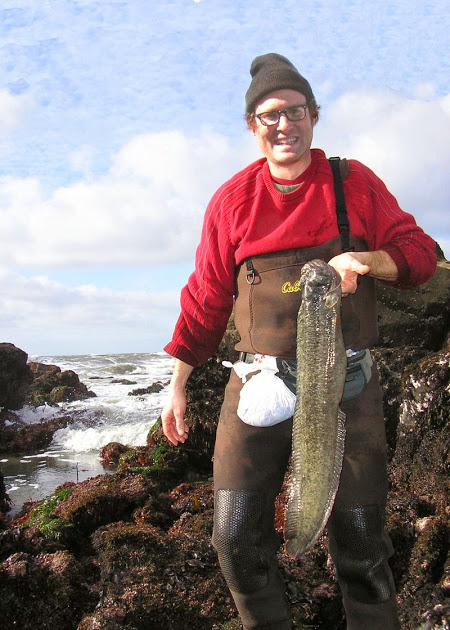
s Lombard works his way along the shoreline, dipping his pole into another crevice, he explains that most fishermen are hesitant to adopt his techniques. “You have to put in hella hours, man!” Lombard says. “It takes a rare breed of man to fish open access.” Lombard says the only fishermen who would take on such exhausting work are young fishermen: “the hungry ones.”
Suddenly Lombard snaps his head around. There’s a tug on the line. “OH!” Lombard shouts, delighted. “Oh, is that you, darling?”
he monkeyface is by no means the only fish to trigger Lombard’s enthusiasm. When we first met, Lombard was wandering the mudflats along the bayshore at San Francisco’s Candlestick Park, flipping over rocks with a garden rake in pursuit of mating pairs of plain fin midshipman that had emerged from the ocean’s depths to procreate. The fish live most of their lives off the continental shelf at a depth of 2,000 feet, but swim up to the mud flats to lay their eggs in the few inches of water beneath the rocks.
The midshipman is interesting for the noise it makes. It is a noise that Lombard likes to imitate, and in his own version it sounds something like this:
“Erraauauuauauggghhh eeeeuuughhh bbbreeueughh.”
Lombard rocks his boots in the mud as he sings. In the fish, the sound originates from the rubbing of the fish’s air bladder at the top of its sex organs; Lombard likens it to “a chorus of Tuvan throat singers from outer Mongolia.”
Lombard’s imitation sounds like this:
The plain fin midshipman is another one of Lombard’s favorite fish. (The list is long and also includes the long-jawed mudsucker and the sarcastic fringe-head). He likes the phosphorescent photo pores that glow blue when the fish eats a certain type of planktonic crustacean, and the “good husband” males that emaciate themselves as their pregnant partners fatten up. But it’s the singing, he says, that really gets him.
On the third rock Lombard hits the jackpot: a fat midshipman. Lombard scoops her up and slides her gently into an orange bucket.
The tide is already coming in, and at 8:30 a.m., Lombard is behind schedule. “I’m running on five hours of sleep,” he says. The day before, he spent seven hours in a beat-up motorboat fishing mackerel with hook and line. Mackerel weigh about three pounds on average. Lombard and his fishing partner caught 150 pounds.
“It’s insane, but I do it because that’s the kind of fish we should be eating!” Lombard says.
Lombard takes the midshipman out of the bucket to show me the photo pores along its belly. When I ask him how he’ll prepare the fish, he squats and Frisbees it lightly into the water.
“Oh, I don’t kill these guys,” he says, “I like them too much.”

arling?” Lombard calls into the monkeyface hole.
When he reaches down, Lombard pulls up a crab about five inches across: impressive, but not what he was looking for.
Some days, Lombard says, still holding the crab and now pointing with it for emphasis, a fisherman doesn’t get what he’s after. Fishermen refer to the experience as a “skunk,” but Lombard and his fishing buddy John Paczkowski came up with a word he says is “more appropriate for the brutal failures of fishing on the California coast” – a “squack.”
The tide is seeping up the rocks now. A Pacific Gas and Electric truck pulls up behind Lombard’s parked pickup and puts on its flashers.
“Ah, we probably have to go,” Lombard says. “They’re just not biting.”
As we clamber up the rocks, Lombard explains his plans to double his seafood clientele, hire help, and focus more on marine education. (Also, he would like to start selling large monkeyface orders again.)
As I drive away, I see Lombard chatting with the PG&E technician, who is using his hose to give Lombard’s car an impromptu car wash.
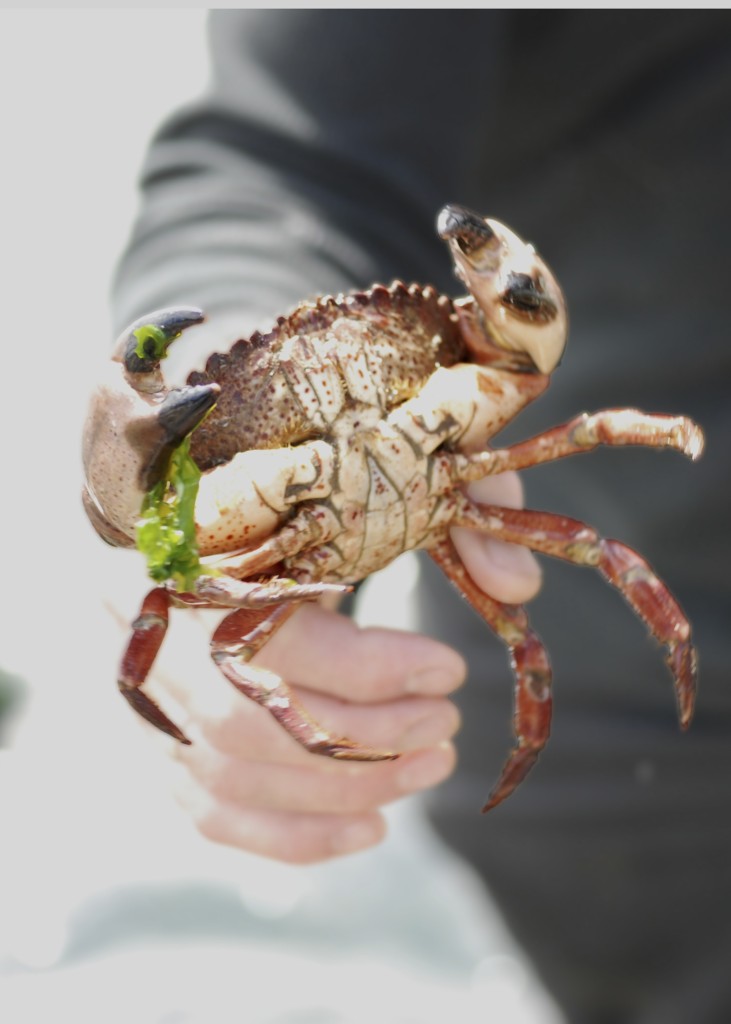
hat about Cambodian Stan?” I asked Lombard two weeks later.
“Now that,” Lombard says, “Is one of the great mysteries.”
Before Lombard embarked on his restaurant-supplying, coastline-touring business endeavors, he spent eight years interviewing fishermen for his job as a fisheries inspector. He has lost count of how many fishermen he talked to, and of all the beaches and docks he visited. But despite all those years with California’s fishermen, the last time Lombard saw Cambodian Stan was the overcast afternoon in 1996 when Stan showed Lombard his poke poling method at Squack Rock.
“I don’t know if he’s dead, alive or an apparition,” Lombard says.
The last image Lombard has of Cambodian Stan is of him scurrying across the intertidal rocks like a crab. He disappeared, as Lombard says, “like a scuttling phantom” into the distance, leaving Lombard with a quest for the darling eels.

